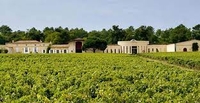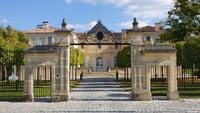Amidst the changes wrought by the pandemic, I recently had the privilege of attending a tasting of 2018 Bordeaux wines sponsored by the Union des Grands Crus de Bordeaux – an organization that includes many top wines from the most famous Bordeaux appellations. This year’s event was much more subdued that that of years past. Instead of meeting winery principals across the tasting table, this was a show for the wines only with far fewer attendees and much less activity. It was, however, an opportunity to get a sense of the overall quality of the 2018 harvest and to discern which communes within the Bordeaux AOP were most successful. Most of these wines will arrive in the US by autumn if they are not in the market already.
Although 2018 is a fine vintage, the Bordeaux wine market is in turmoil along with the rest of the world. The pandemic wrought massive changes in the way wines are purchased and consumed. Restaurants that had been Bordeaux buyers for years have needed to scale back purchases or may be out of business. Thus, prices for the 2018 wines have not risen as sharply as they might have in more “normal” times. The Bordelais vintners are very pleased with the result of the ’18 harvest, and comparisons to 2016 and 2015 are often made. As always, careful shopping is required to find the best values, but a quick comparison shows that prices for the 2018’s, while slightly up from 2017, are about the same as 2016 and 2015. Some chateaux are even a bit less expensive than those two exalted vintages.
The weather of 2018 was quite different from the previous harvest. A severe frost in April of 2017 caused significant vine damage in some regions and the vines were still recovering from that distress. In 2018 winter was slightly cooler than average and spring slightly warmer. There was no vine-damaging cold, but there was quite a bit of rain from January through June. Because of the constant moisture, downy mildew was a constant problem. The impact was severe on some organic and biodynamic estates, reducing the crop to one-third of average or less. There was a fortuitous window of good weather for flowering in late May. Hailstorms in May and again in July visited their usual havoc on a few vineyard sites, but damage was not widespread.
At the end of June, the weather turned warm and dry for the balance of the growing season. The grapes developed deep color and rot was not a problem. The early season rains provided a reservoir of moisture that allowed grapes to enjoy the sun of the late summer without undue stress. Harvest commenced under ideal conditions and vintners had the luxury of choosing the best moment to pick without impending weather challenges.
The overall harvest was successful in almost all areas. Although the grapes were very ripe and some alcohol levels high, the stored water allowed pH levels to be low, resulting in a delicious combination of ripeness and freshness. With Merlot, Cabernet Franc and Cabernet Sauvignon all able to ripen fully, there is a multitude of fine Left and Right Bank wines to consider. Botrytis did not develop very much until late in the fall and the Sauternes wines can be less opulent than in years with greater botrytis development.

Domaine de Chevalier in Pessac-Léognan
Of the 106 wines I tasted, 13 were dry whites, 5 were Sauternes and the remaining 88 reds. Prices vary widely in every Bordeaux market. I have listed average prices for comparison. Among the dry whites of Pessac-Léognan, the 2018 Domaine de Chevalier Blanc ($108) was my favorite of the vintage. The purity of fruit, layered complexity and overall finesse sets the Chevalier apart from other wines. Other superb whites were the Larrivet Haut-Brion ($65) Pape Clément ($198), Fieuzal ($79), La Louvière ($30) and Smith Haut Lafitte ($160).
The red wines of Pessac-Léognan were among the best I have tasted in recent vintages from this appellation. Château Pape Clément ($141) showed rich and ripe fruit along with the firm, earthy structure classic to Graves reds. Other excellent wines were from Domaine de Chevalier ($98), Bouscaut ($35), Carbonnieux ($57), Larrivet Haut-Brion ($59), Haut-Bergey ($28) and Smith Haut Lafitte ($151).
There were excellent wines from all the Left Bank communes. In St. Estèphe, Lafon-Rochet ($57) was my favorite of the tasting, followed by Château de Pez ($59), Château Phélan Ségur ($75) and Château Ormes de Pez ($50). St. Estèphe, as always, offers some excellent values in this vintage.
The top Pauillac wines are truly great and worth cellaring for even greater development in years to come. The Pichon Longueville Comtesse de Lalande ($227) topped my list, followed closely by Pichon Baron ($224) and Grand-Puy-Lacoste ($90). Excellent efforts from Duhart-Milon ($116), Lynch-Bages ($176), d’Armailhac ($84) and Clerc-Milon ($124) rounded out an impressive array. The classic power and finesse of Pauillac was evident in all these wines.
In St. Julien, Léoville-Barton ($111) and Léoville-Poyferré ($127) were again my favorites, with velvety fruit and layers of herb, cocoa and spice flavors. Châteaux Beychevelle ($129), Branaire-Ducru ($93), Lagrange ($75), Gruaud-Larose ($111) and Saint-Pierre ($76) were also excellent.

Château du Tertre in Margaux
Moving on to the Margaux appellation, Château Brane-Cantenac ($93) showed the classic, sleek and layered style of Margaux. A plethora of exceptional wines were shown from Chateaux Lascombes ($120), Giscours ($100), Desmirail ($69), Prieuré-Lichine ($71), Rauzan-Ségla ($159), Siran ($44), du Tertre ($69) and Cantenac-Brown ($90). The commune of Margaux has much to offer in 2018.
Château Poujeaux ($44) in Moulis-en-Médoc offers a ripe, elegant and refined wine in 2018. The Haut-Médoc appellation had a spate of great value stars in Château Cantemerle ($55), Château de Lamarque ($30), Château de Camensac ($46), Château La Tour Carnet ($43) and Château Coufran ($26).
The Right Bank wines of 2018 are ripe, layered and balanced as well. Saint Émilions that topped my list were Beau-Séjour Bécot ($97), Canon ($155), Canon-La-Gaffelière ($118), Clos Fourtet ($145), Larcis-Ducasse ($100), Troplong-Mondot ($149), Pavie Macquin ($109) and Valandraud ($194). Château La Tour Figeac ($44) in St. Émilion is a great bargain from the Right Bank. Of the Pomerols tasted, Clinet ($134), La Croix de Gay ($54) and Gazin ($104) were my favorites
As mentioned, only five Sauternes bottlings were included in the tasting and they showed a lighter style that other recent vintages. Châteaux Bastor-Lamontagne ($50) and Coutet ($50) were my favorites of those tasted.
The wines represented in the Union des Grands Crus de Bordeaux tasting were from the top 5% of all Bordeaux wines. The prices listed reflect that position. I believe, however, that turmoil in the pandemic-affected market has subdued the effusive press about the 2018 vintage. In previous years, a vintage of this quality would likely have garnered much more attention and pushed prices higher than those in the current market. There are some great wines here and this can be a buying opportunity for Bordeaux lovers.
As always, there is much more to discover among the thousands of other Bordeaux produced every year. In a ripe vintage like 2018, lesser-known estates can often produce exceptional wines. A careful shopper can find excellent wines in a $15-$20 price range.